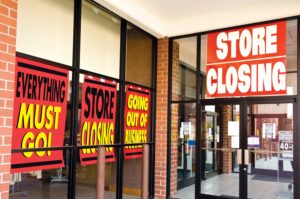Navigating Troubled Waters: Avoiding Retailer Liquidation
Despite the end of the pandemic, several resilient retail chains and franchises found themselves facing ongoing challenges. Rather than making resolutions, this period of the retail apocalypse brought forth an entirely new set of issues, while also amplifying existing ones. We saw shifts in consumer preferences and purchasing patterns, escalated expenses, disrupted supply chains, scarcity in skilled labour, reduced access to cheap loans, increased debt, and more.
Insufficient research into the Canadian market, logistics issues, insufficient economies of scale coupled with poor managerial choices compelled prominent retailers like Bed, Bath & Beyond and Nordstrom to scale down or exit their operations in Canada over the last year. Concurrently, beloved Canadian retail brands such as David’s Tea, L’Occitaine, Aldo, Reitmans, Bizou, National Sports, and Pier One faced severe blows, leading them to either close operations, transition to online stores, become wholesalers, or significantly reduce and / or modify their brick-and-mortar presence.
Canadian chains: Fear the walking dead
Zeroing in on the Canadian carnage, we know Reitmans and other similar chains got bludgeoned by the pandemic, as physical distancing mandates forced retail locations to close stores and move towards online shopping. Despite feeling this pain, Reitmans was already juggling financial problems prior to 2020. In its 2019 fiscal year, company sales fell by $53.5 million, a 5.8% drop from the previous year. Reitmans posted a net loss of $87.4 million for the FY ending Feb 1, 2020. By May, Reitmans stated that unless it could secure short-term financing to pay its bills “it may be unable to continue as a going concern.”
In an interview with CBC News, retail consultant Doug Stephens rather pointedly noted that for humans and businesses alike “COVID-19 really does seek out pre-existing underlying problems and one of those is an over reliance of physical stores for the distribution of your goods.” Pre-pandemic, Reitmans had tried to address that by shutting underperforming stores, in particular those in the plus-sized segment, like its Penningtons and Addition Elle brands. Consumer confusion on disparate branding, product SKUs and fashion trend strategy, accelerated the loss in turnover and profitability.
In a bid to revitalize their business, Reitmans seemingly adopted a range of common strategies employed by struggling retailers aiming to reclaim stability. These tactics encompassed cost-cutting measures and restructuring initiatives, as well as optimizing store locations for greater efficiency. The company also focused on bolstering their online presence by investing in a more robust e-commerce platform. To cultivate stronger customer relationships, Reitmans prioritized customer engagement through personalized emails and timely promotions. Employing dynamic product strategies, such as alternating discounts on different items, helped maintain the loyalty of their clientele. Additionally, the company emphasized effective financial management by optimizing resource utilization. Customer feedback was actively sought and valued, allowing Reitmans to attentively listen to reviews and respond to evolving consumer needs. These combined efforts likely contributed to the company’s efforts to turn around the business and foster a path toward sustained growth and success. Reitmans focus was not on closing locations or inventory ROI, but it was building tools to transition retail customers in a digital relationship or connecting with them in a near-by location despite store closures.
Slipping into the cracks
For Montreal-based chain David’s Tea there was no viable way around the pandemic’s destructive effects. Its shops had been both meeting places and retail outlets. But by June of 2020, unable to pay the rent on any of its shuttered locations, management announced it was looking at restructuring. In the end, it filed for bankruptcy, having shrunk from 240 stores to just 18, and switching focus away from retail, into ecommerce and wholesale.
Looking back though, as early as 2016, investors were jittery about David’s Tea after its IPO debacle. Investment site Seeking Alpha said in December of that year that “David’s Tea has been a disaster for IPO investors, unable to turn a profit and with high turnover in the C-Suite.” The IPO was supposed to help it launch its US ops and make it a shopping mall superstar.
David’s Tea implemented several common strategies to maintain their presence in the market despite set-backs. They conducted market research and analyzed sales data, benefiting from a consistent income stream through their online store. By not having physical stores, they could allocate more budget to test innovative products. Additionally, they adopted an omni-channel sales approach, providing loyal customers with various options. Furthermore, the company closed all 42 of its U.S. locations in July 2020, as well as 82 Canadian stores, as part of a restructuring plan that would shift the tea chain to focus more online and on wholesale embracing a new side of technology. The fluctuation of store closures over the last few years, and the business landscape moving forward signifies the importance of having a strategic plan in place for online and in-store shopping for any businesses.
A kick in the jewels
Bizou, a Canadian jewelry store wannabe juggernaut is another lesson in subpar management. More than four decades after its founding, the brand had 45 stores in Quebec and New Brunswick. But by January 2023, the company announced that all 45 stores would close, and Bizou International Inc. would officially file for bankruptcy. Bizou blamed its demise on low traffic in shopping centers, competition from online retailers and, yes, the pandemic.
There were also increased operating costs, challenges in sourcing merchandise and the sudden death of the brand’s founder, Marcel Labrecque, which was decisive for the future of the company. Bizou depended on customers coming to stores and, in the end, was not equipped to deal with a mass consumer movement toward online shopping. Amazon, and other competitor retailers were swallowing much of its customer base. Somehow that trend was missed by management, a fact made bitter and ironic considering that back in 2015, Bizou was planning to open-up 300 stores in Canada.
Right-sizing their footprint
Aldo, the Montreal-based fashion shoe retailer, established in 1972 and operating in over 100 countries, sought protection under the CCAA in 2020. The company cited various factors contributing to its insolvency, including:
The impact of the pandemic on its operations
- Evolving buying habits among its customer base resulting in decreased purchases
- Excessive brick-and-mortar locations
- Unprofitable overseas ventures
- Too many unprofitable retail concessions in department stores
- Growing competition from online sellers
Prior to filing, the shoe retail industry had already been consolidating with the closure of several competing chains. Aldo had faced profitability challenges for a number of years and was amidst a strategy review focused on reducing retail stores, transitioning to e-commerce, wholesale, and franchising.
Unfortunately, the pandemic did not allow enough time to fully implement these changes, resulting in significant losses of $75 million and $53 million on Canadian and US operations, respectively, shortly before filing.
Fortunately, the company underwent a successful restructuring process based on its pre-existing implementation plan. This involved a significant reduction in stores and employees, as well as a shift in product lines leading to reduced product SKU selection and more comfortable attire. Overseas operations were also scaled down and refocused towards wholesale.
Would repositioning have helped such retailers?
The failure of these companies shows how easy it is to get into trouble by not keeping brands strong, not updating merchandise, not tuning in to consumers and staff, and not keeping abreast of emerging competitive realities. But what about turning them around once the damage is well underway or already done?
The fate of nearly all retailers is dependent upon their ability to:
- Timely analyze their brick-and-mortar footprint
- Stay ahead of admin costs
- Demonstrate to creditors that a restructure / reorganization of the business will yield greater returns than a liquidation of inventory.
Does downsizing a business immediately fix the problem?
Downsizing a business can be a strategic decision to address certain problems or challenges, but it does not guarantee an immediate fix for all issues. It’s essential to understand that downsizing is a complex process that involves reducing the size of a company, often by cutting costs, laying off employees, or divesting certain assets or business units. Downsizing can help when sales are weak in certain regions or stores. But if management is not up to the job, not sufficiently managing the overall brand and not listening to customers, downsizing is the wrong solution. Similarly, failure to understand changing retail landscapes is not likely to be helped by downsizing. Historically, retailers would measure success at a store level, but post-pandemic the first step in the journey of transitioning customers to online stores is creating a variety of experiences
Sometimes it’s all too much for the existing C-suite occupants
The experienced partners at Zeifmans are adept at enabling businesses resolve crises with sound, creative solutions that meet the needs of all stakeholders. At times, management can be overwhelmed with day-to-day operations to devote time to identifying issues and creating solutions. Likewise negotiating with lenders and creditors is a difficult task when you have lost your credibility. The Zeifmans Team has worked with many types of distressed businesses in multiple industries. Through our international network, we also offer multi-jurisdictional assignment solutions.
Our deep retail experience has seen us work with distressed retailers to identify all kinds of issues including:
- Poor MIS systems resulting in inaccurate or lack of timely information regarding inventories, sales / profit by product lines and locations
- Management unsuited to guiding their companies through changing economies and shifting industry trends
- Brand depreciation as a result of frequent sales & promotions
- Failure to recognize the need for new product introductions, stale product lines
- Changing fashion trends
- Franchising issues, primarily food-based retailers
- Inadequate capitalization this is a big one with retail expansion without sufficient equity support
- Too much emphasis on sales turnover and other KPIs without attention to product margins
- Increasing product lead times from overseas suppliers
If your company is experiencing any of the above issues or entering choppy waters, a frank discussion with a Zeifman’s turnaround professional can be the start of a new and viable way forward. Email us at info@zeifmans.ca or chat directly with Allan Rutman, Turnaround Management and Insolvency Advisor/CRO at 416.861.1487.




